Yamaha YZF-R125 Service Manual: Replacing the rear brake pads
NOTE:
When replacing the brake pads, it is not necessary to disconnect the brake hose or disassemble the brake caliper.
1. Remove:
- Brake pads
- Brake pad spring
NOTE:
To remove the inner brake pad "1", push down on the brake caliper bracket so that there is space to remove the brake pad.
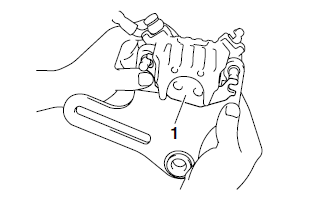
2. Measure:
Brake pad wear limit "a"
Out of specification → Replace the brake
pads as a set. 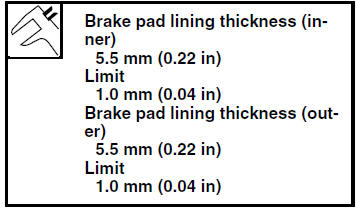
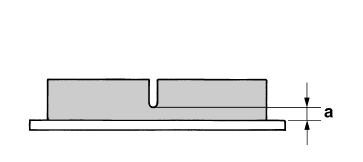
3. Install:
- Brake pad spring

- Brake pads

NOTE:
Always install new brake pads and a new brake pad spring as a set.
a. Connect a clear plastic hose tightly to the bleed screw. Put the other end of the hose into an open container.
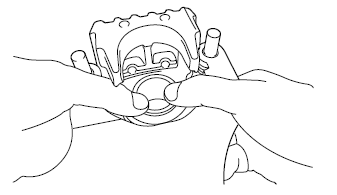
b. Loosen the bleed screw and push the brake caliper piston into the brake caliper with your finger.
c. Tighten the bleed screw. 
d. Install a new brake pad spring "1" and new brake pads.
NOTE:
Install the brake pad spring as shown.
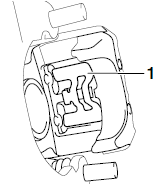
4. Install:
- Brake pad retaining bolts
- Brake caliper

5. Install:
- Rear wheel Refer to "REAR WHEEL" on page 4-12.
6. Check:
- Brake fluid level
Below the minimum level mark "a"
 Add the
Add the
recommended brake fluid to the proper level.Refer to "CHECKING THE BRAKE FLUID LEVEL" on page 3-18.

7. Check:
- Brake pedal operation
Soft or spongy feeling
 Bleed
Bleed
the brake system.Refer to "BLEEDING THE HYDRAULIC BRAKE SYSTEM" on page 3-20.
 Checking the rear brake disc
Checking the rear brake disc
1. Remove:
Rear wheel
Refer to "REAR WHEEL" on page 4-12.
2. Check:
Brake disc
Damage/galling → Replace.
3. Measure:
Brake disc deflection
Out of specification → Correc ...
 Removing the rear brake caliper
Removing the rear brake caliper
NOTE:
Before disassembling the brake caliper, drain
the brake fluid from the entire brake system.
1. Remove:
Union bolt "1"
Copper washers "2"
Brake hose "3"
NOTE:
Put the end of th ...
Other materials:
Adjusting the engine idling speed
NOTE:
Prior to adjusting the engine idling speed, the air
filter element should be clean, and the engine
should have adequate compression.
1. Start the engine and let it warm up for several
minutes.
2. Remove:
Rider seat
Refer to "GENERAL CHASSIS" on page 4-1.
3. Lift the fuel tank. ...
Installing the drive chain
1. Lubricate:
Drive chain
Master link
2. Install:
Drive sprocket
Drive sprocket retainer bolts
3. Install:
Master link
O-rings
Master link plate
Master link clip "1"
CAUTION:
The closed end of the master link clip must
face in the direction of drive ch ...
Checking and lubricating the cables
The following procedure applies to all of the inner
and outer cables.
WARNINGDamaged outer cable may cause the cable to
corrode and interfere with its movement. Replace
damaged outer cable and inner cables
as soon as possible.
1. Check:
Outer cable
Damage Replace.
2 ...
